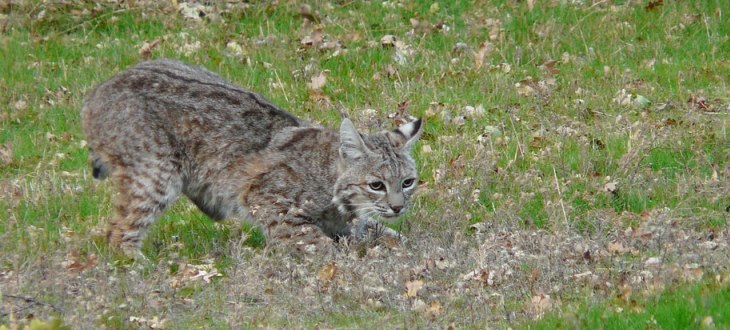The State We're In
UN report sounds alarm on nature’s decline
Would you care if northeastern beach tiger beetles and arogos skipper butterflies disappeared? How about blue-spotted salamanders and southern gray tree frogs, or peregrine falcons and piping plovers? What if bobcats, Indiana bats and North Atlantic right whales vanished?
All of these creatures are on New Jersey’s list of endangered species, and their prospects for survival in this state we’re in are in danger. Sadly, they are part of a much, much larger global list.
Of the approximately 8 million plant and animal species on Earth, one million are in danger of becoming extinct, largely due to impacts from a single species – humans.
That’s the conclusion of the “Global Assessment,” a new report from the United Nations’ Intergovernmental Science-Policy Platform on Biodiversity and Ecosystem Services.
Put together by hundreds of scientists and authors around the world, the Global Assessment is the most comprehensive update on the status of the Earth’s species. It reaches several shocking conclusions: that nature is declining at rates “unprecedented” in human history, that the rate of extinction is speeding up, and that our current response isn’t enough to reverse the declines.
“The health of ecosystems on which we and all other species depend is deteriorating more rapidly than ever,” said Sir Robert Watson, the British scientist and climate change authority. “We are eroding the very foundations of our economies, livelihoods, food security, health and quality of life worldwide.”
The Global Assessment lists five main culprits in the rapid decline of species:
- Changes in land and sea use, which have reduced habitats for animals and plants;
- Exploitation of animals and plants, including unsustainable harvesting of fish and shellfish;
- Climate change, which is raising Earth’s temperature, causing sea level to rise and changing weather patterns;
- Pollution, which has degraded habitats and food sources for wildlife;
- Invasive alien species, which crowd out native species.
The Global Assessment notes that, since 1980, greenhouse gas emissions have doubled, raising average global temperatures by at least 0.7 degrees Celsius. Climate change is already impacting nature and ecosystems, the report said, with impacts expected to increase over the coming decades.
According to the report, immediate, “transformative” changes are essential. “The report tells us that it is not too late to make a difference, but only if we start now at every level, from local to global,” said Sir Robert, who chairs the committee that produced the report.
How can you help?
First, take a look what’s at stake. Start with the Photo Ark, an online project of National Geographic photographer Joel Sartore. Joel set out in 2005 to create beautiful portraits of thousands of animals and plants threatened by extinction. So far, he’s photographed 9,585 species.
His goal, very simply, is to get people to care enough to take action. The portraits “give us all a chance to look animals directly in the eye and see that there’s beauty, grace, and intelligence in the other creatures we share the planet with,” he writes.
Joel notes that all species are important to human survival: “We need bees and even flies to pollinate the fruits and vegetables we eat. We need intact rain forest to regulate the amount of rainfall we get in areas where we grow crops.” Beyond that, he believes every species has a basic right to exist.
Once you’ve seen a fraction of the animals and plants at risk, what can you do? For starters, change some habits and reduce your own “footprint.”
- Use less fossil fuels and support efforts to switch to clean, renewable energy.
- Be thoughtful about food. Eat local foods, because they don’t have to be trucked long distances; eat organic foods, because they’re grown without chemical pesticides and fertilizers; say no to seafood that’s not sustainably harvested; and eat less meat, because meat production uses more energy and water, and creates more pollution than growing vegetables.
- According to the Global Assessment, plastic pollution has increased tenfold since 1980, affecting many aquatic species. Avoid products with excess packaging – especially plastics – and recycle, reuse, repurpose and compost everything you can.
- And one of the very best ways to help is to support efforts to preserve and restore the habitats of struggling species.
Here in New Jersey, many public and private agencies are preserving and restoring natural habitats for rare and endangered species. New Jersey has 50 animal species – mammals, birds, reptiles, amphibians, fish and insects – that are considered endangered, and another 30 that are threatened.
No one can stop species loss singlehandedly, but everyone can do something – and usually many things. Together, many small actions add up!
To learn more about the Global Assessment, go to https://www.un.org/sustainabledevelopment/blog/2019/05/nature-decline-unprecedented-report/. To see Joel Sartore’s portraits of imperiled animals and plants from around the world, go to https://www.joelsartore.com/photo-ark/.
To see the list of New Jersey animals classified as endangered and threatened, go to https://www.nj.gov/dep/fgw/tandespp.htm.
And for information about preserving New Jersey’s land and natural resources, visit the New Jersey Conservation Foundation website at www.njconservation.org or contact me at info@njconservation.org.
About the Authors
Alison Mitchell
Co-Executive Director
John S. Watson, Jr.
Co-Executive Director
Tom Gilbert
Co-Executive Director, 2022-2023
Michele S. Byers
Executive Director, 1999-2021
View their full bios here.
Filter
Get The Latest News
From The Garden State
In the
News

